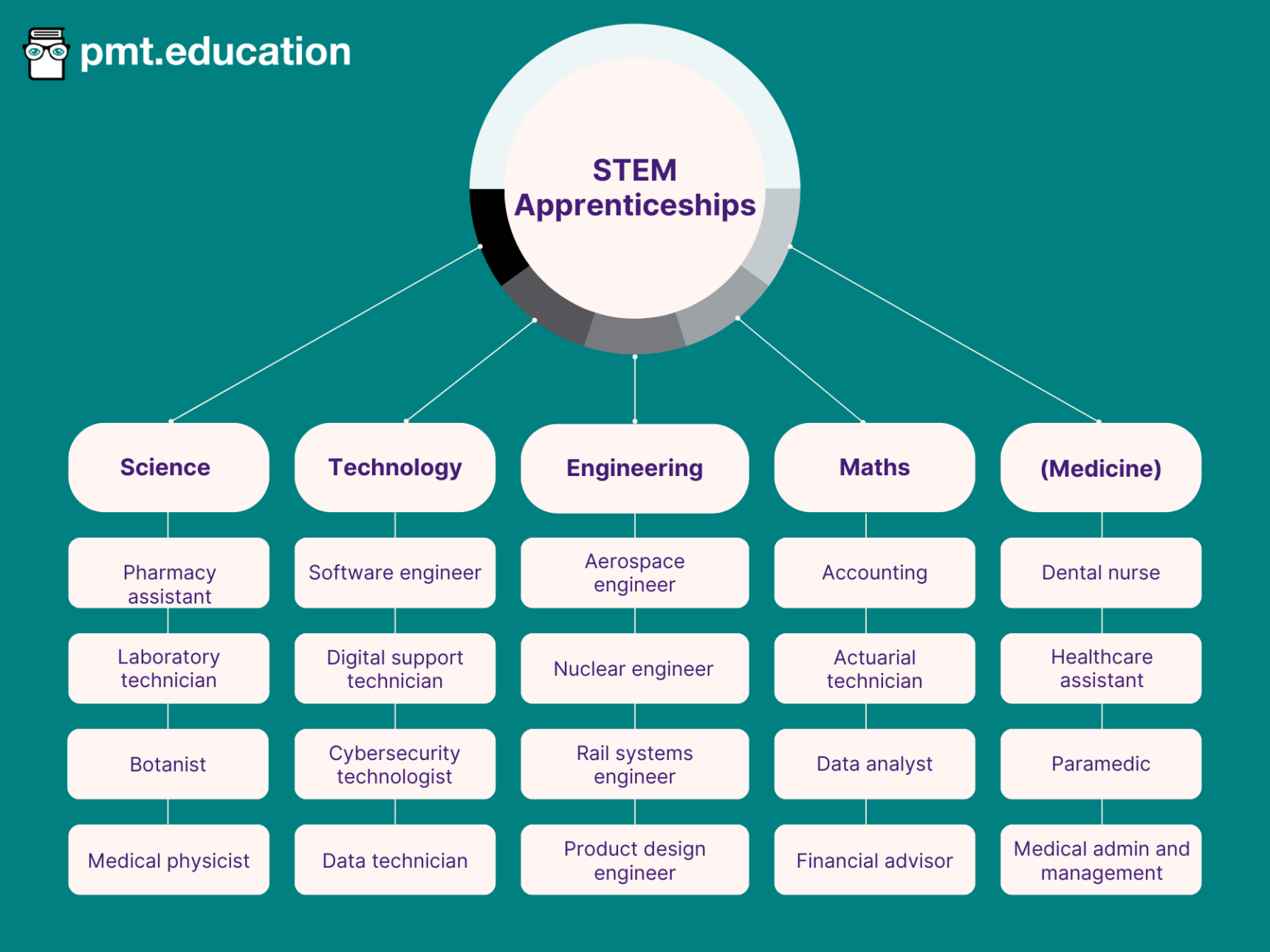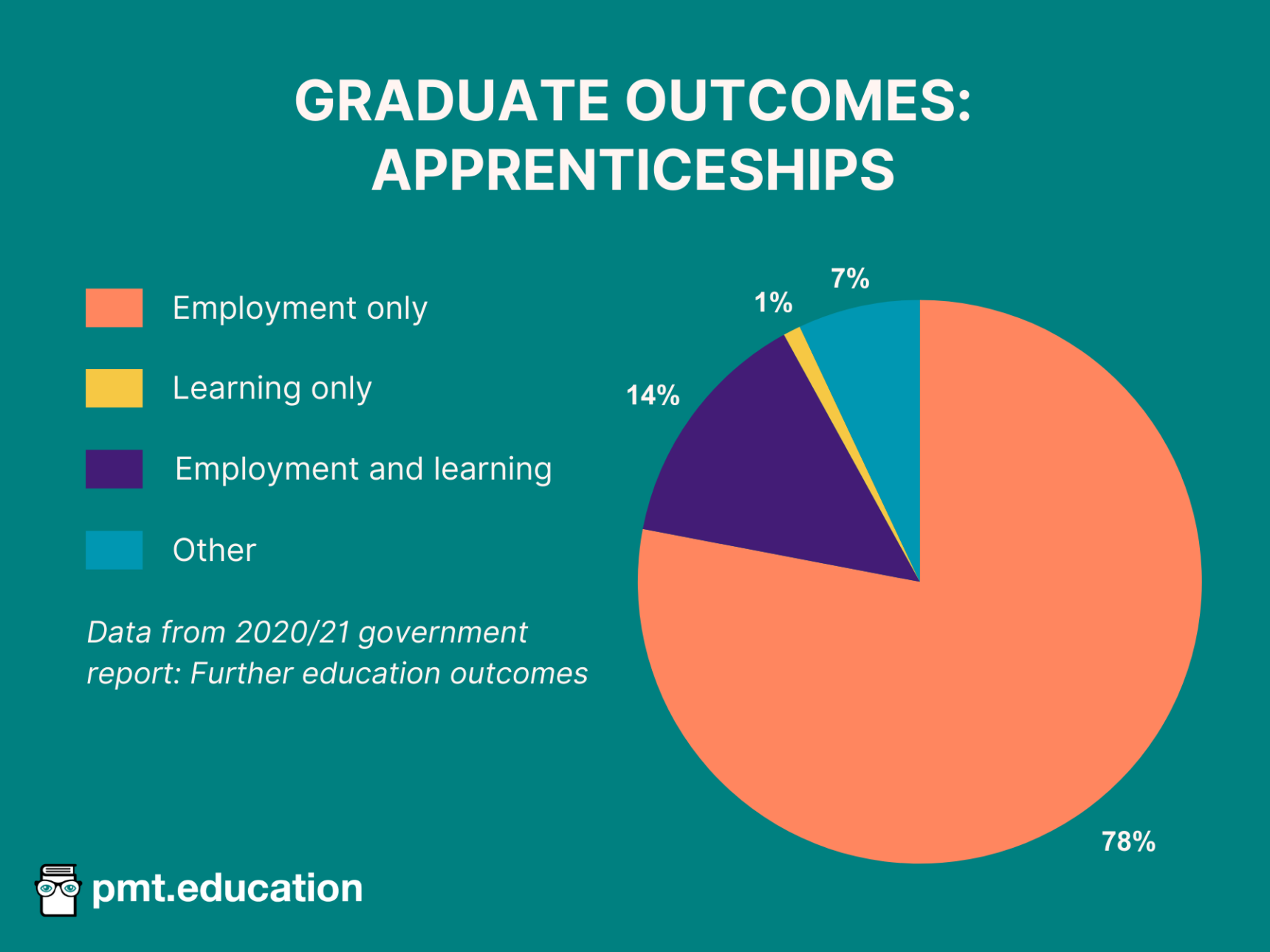Contents:
Qualification Level: Level 2 to 7
Age Group: 16+ years
Cost: Earn a wage, employer and government-funded
Skills Developed: Job-specific, practical skills
Learning Environment: Workplace-based, with classroom learning
What is an apprenticeship?
An apprenticeship is a form of vocational training where you earn a respected qualification while gaining practical experience with an employer. Apprenticeships are available for those over the age of 16 at various levels (from GCSE to degree). They enable you earn at least the national minimum wage while acquiring valuable skills in your chosen STEM field.
Unlike traditional academic routes, apprenticeships place you directly in the real-world work environment, offering an education tailored to your career goals. If you’re drawn to the hands-on aspects of STEM, have a specific job in mind, or want an education beyond traditional academics, an apprenticeship could be an ideal option for you.
Considering an apprenticeship as a post-18 option? You may find our article dedicated to degree apprenticeships more helpful.
What STEM apprenticeships are available?
There are hundreds of apprenticeship types across various industries. Here are just a few examples of STEM apprenticeships:

Top employers offering STEM apprenticeships
STEM apprenticeships are available across various sectors, with leading employers providing opportunities in science, technology, engineering, mathematics, and medicine.
- Science: GSK, RSPCA, Thames Valley Police
- Technology: Google, Amazon, ITV, BT
- Engineering: Jaguar Land Rover, Airbus, Network Rail
- Maths: Lloyds Bank, Coca-Cola, Santander, HMRC
- Medicine: NHS, private dental practices, local medical centres, Boots
You also have the option to complete a wide variety of apprenticeships online, which not only expands your opportunities but also offers greater flexibility.
To find out more about apprenticeships available in STEM, you can read this overview of apprenticeship opportunities compiled by the UK Government.
How do STEM apprenticeships work?
While each STEM apprenticeship is unique, they share common themes. Here, we will explore these themes and direct you to valuable resources for more information.
A day in the life of a STEM apprentice
As a STEM apprentice, you need to spend at least 20% of your working hours on training or studying. This typically translates to one day a week dedicated to learning. However, in the example timetable below, 20% of each working day is set aside for this purpose.
Here is an example timetable for a typical STEM apprentice:
| Time | Tasks |
|---|---|
| 9:00 | Arrive at the same time as full-time employees Review the schedule for the day Discuss ongoing projects with your mentor or supervisor |
| 10:00 | Complete hands-on tasks such as setting up equipment, conducting experiments or performing technical procedures under supervision (depending on the field of work) |
| 11:00 | Undertake structured learning sessions for the day. This could include attending workshops, seminaries or classes at the workplace or a partnering educational institution. |
| 12:30 | Lunch break |
| 13:00 | Collaborate with colleagues and other apprentices on the project at hand. This could include brainstorming ideas and participating in meetings |
| 14:00 | Continue with practical project work from the morning |
| 16:00 | Receive feedback from mentors or supervisors Update project documentation and log progress Reflect on your learning from the day |
| 17:00 | End of day |
This example timetable highlights how your time as an apprentice is divided into practical hands-on experience and formal ‘off-the-job’ training, where you gain theoretical knowledge through study.
How are STEM apprenticeships assessed?
As an apprentice, your skills and knowledge will be evaluated through an End-Point Assessment (EPA) at the conclusion of your apprenticeship. To complete the apprenticeship and earn any associated qualifications, you must pass this assessment.
The EPA varies based on the level and type of apprenticeship and must meet industry standards. Frameworks for these standards are set by independent organisations such as Sector Skills Councils or Trailblazers (England), which outline the essential knowledge, skills, and behaviours (KSBs) required for each apprenticeship.
The EPA involves a series of independent tests to evaluate whether you’ve demonstrated the necessary KSBs. These tests include at least two of the following:
- Practical assessment
- Interview
- Project
- Written and/or multiple choice test
- Presentation or sales pitch

You will be awarded a pass, merit or distinction based on your performance. The EPA is carried out by a government-approved organisation (EPAO) or an impartial party to ensure fairness and consistency across different apprenticeship programmes.
For detailed information on the EPA, visit the government webpage.
What qualifications can you get from a STEM apprenticeship?
Upon completion, you’ll earn an internationally recognised qualification that you can put on your CV.
The main qualification you get is the apprenticeship itself. More specifically, you’ll complete an apprenticeship standard, such as Healthcare Science Assistant L2 Standard or Carpentry and Joinery Apprenticeship Standard.
In addition to the main qualification, employers may provide complementary qualifications, including:
- National Vocational Qualifications (NVQs)
- Knowledge-based qualifications such as foundation degrees, HNDs, HNCs
- Functional skills qualifications such as in English, Maths and IT
- Technical certificates such as BTECs or City & Guilds awards
How long are apprenticeships in STEM?
Apprenticeships typically take between 1 and 5 years to complete, depending on the level. To be considered a full-time apprentice, you need to work at least 30 paid hours a week, though some employers may require up to 40 hours. If you have shorter working weeks, you’ll be classified as a part-time apprentice and the length of the apprenticeship will be extended accordingly.
Please note that if you are under 18, you cannot work more than 40 hours per week by law.
How much do apprenticeships pay?
You are entitled to at least the National Minimum Wage for apprentices, which varies with age group. As of April 2024, this stands at:
- Aged 16 to 18: £6.40/hour
- Aged 19 or over and in your first year of apprenticeship: £6.40/hour
- Aged 19 to 20 and have completed your first year: £8.60/hour
- Aged 21+ and have completed your first year: £11.44/hour
You must be paid for all aspects of your apprenticeship including your regular working hours, training (which should account for at least 20% of your working hours), and study towards English and maths qualifications. These salaries are the minimum you should receive and many employers offer higher pay. You’re also entitled to at least 20 days of paid holiday per year, along with other employee rights such as sick pay.
If you are ever worried about getting underpaid, you can check using the National Minimum Wage and Living Wage calculator for workers provided by gov.uk.

Which apprenticeship level should you apply for?
Apprenticeships are sorted into levels depending on the qualifications you need to apply and the stage of education they correspond to, similar to Key Stages in school.
Categorisation of apprenticeships: England
- Intermediate (Level 2): Equivalent to five passes at GCSE. Typically lasts 12 to 18 months with no specific eligibility criteria. However, if you haven’t passed GCSE English and Maths, you must continue with these subjects until you pass them or complete your apprenticeship.
- Advanced (Level 3): Equivalent to two passes at A Level. Often requires at least 5 GCSEs, completion of an intermediate apprenticeship, or sometimes relevant industry experience. Usually lasts 18 to 48 months (full-time).
- Higher (Level 4 or 5): Level 4 is equivalent to a Certificate of Higher Education (CertHE) or Higher National Certificate (HNC); Level 5 is equivalent to a foundation degree, the first year of an undergraduate degree, or a higher national diploma (HND). Entry typically requires completion of an advanced apprenticeship, a BTEC National qualification, two A Levels, or a Level 3 NVQ. Duration is at least 48 months.
- Degree (Level 6+): Offers a full bachelor’s (Level 6) or master’s (Level 7) degree while working. Entry requirements are similar to university, often including specific GCSE and A Level grades, plus transferable skills like communication and time management. Duration ranges from three to six years depending on the level of the apprenticeship.
Entry requirements for apprenticeships vary, much like they do for universities. If you don’t meet the requirements for the first apprenticeship you find, don’t give up! There are many alternative vocational education options available to explore as well.
The above information is summarised in the table below:
Categorisation of apprenticeships: Elsewhere in the UK
- Scotland: Apprenticeships are categorised into foundation apprenticeships (SCQF 5-6), modern apprenticeships (available at SCQF 5-11, depending on your existing qualifications), and graduate level apprenticeships (SCQF 8-11). For further details on Scottish apprenticeships, visit the Scottish government website.
- Wales: Apprenticeships are divided into four types: foundation apprenticeships (Level 2), apprenticeships (Level 3), higher apprenticeships (Level 4 to 5), and degree apprenticeships (Level 6 to 7). For further details on Welsh apprenticeships, visit the Welsh government website.
- Northern Ireland: Apprenticeships are split into Level 2, Level 3 and Higher Level apprenticeships (Level 4+). For further details on Northern Irish apprenticeships, visit Northern Ireland’s government website.
Explore my options with a STEM apprenticeship
Apprentice graduate prospects
Apprenticeships can open many different doors. Below is a summary of the data from a government study of 2020/21 about destinations of apprentices.

A 2022 government study reports that there is high satisfaction among apprentices.
- 99% of individuals who finished their apprenticeships said they acquired new skills during the program
- 95% of apprentices noted at least one positive impact on their job since beginning or finishing their apprenticeship
- 70% of apprentices currently in training planned to remain with their employer after completing their apprenticeship
How do you apply to do a STEM apprenticeship?
Applying for a STEM apprenticeship is much like applying for a job. Here’s a detailed breakdown of the process:
Finding a STEM apprenticeship
Apprenticeship vacancies can be found in several ways:
- Employer websites: Some employers advertise apprenticeships on their own websites, where you can apply directly.
- Apprenticeship fairs: These events feature stalls from various apprenticeship providers offering information on available apprenticeships.
- Government services: The ‘find an apprenticeship’ government service allows you to browse, search for, and apply for apprenticeships. You can save vacancies to revisit later and set alerts for new openings in specific regions or sectors.
Here are the links to the ‘find an apprenticeship’ services for different parts of the UK:
- England’s ‘find an apprenticeship’ service
- Scotland’s ‘find an apprenticeship’ service
- Wales’ ‘find an apprenticeship’ service
- Northern Ireland’s ‘find an apprenticeship’ service
STEM apprenticeship checklist: Things to look for in your search
- Duration – How long is the placement for?
- Entry requirements – Do you need any qualifications or prior experience?
- Qualifications – Which qualification(s) will you get upon completion of the apprenticeship?
- Apprenticeship standards – What will be expected of you? What industry regulations will you need to meet by the end of your apprenticeship?
- Job role – What will you actually be doing, and will you enjoy it?
- Accreditation – Is the placement recognised by the relevant organisations or committees? (e.g. Engineering Accreditation Board for engineering apprenticeships)
- Reputation – Has this employer had apprentices before? What do people think of the employer and the placement they offer?
- Employment – If the apprenticeship is advertised by a training provider, does the vacancy include a job placement or will you need to find one? Will your training provider help you find a suitable job placement?
The application process
- CV: Highlight relevant experience, education, skills, and achievements. Tailor your CV to the specific apprenticeship.
- Cover letter: Write a personalised cover letter explaining why you are interested in the apprenticeship, how your skills and experiences make you a good fit, and your career aspirations.
- Application form: Some employers may require you to fill out an application form instead of or in addition to a CV and cover letter. Provide detailed and accurate information, showcasing your qualifications and enthusiasm.
- Submit applications: Apply to multiple apprenticeships to increase your chances of success. Use online portals, email applications, or direct submissions through employer websites.
- Prepare for interviews: If shortlisted, you will be invited to an interview. Research the company and the role, prepare to discuss your experiences and skills, and think about questions you might be asked. Practise common interview questions and scenarios relevant to the apprenticeship.
- Follow up: After the interview, send a thank you email reiterating your interest in the apprenticeship and appreciating the opportunity to interview.
What are employers looking for in STEM apprenticeship candidates?
Different STEM apprenticeship vacancies have different requirements, so it’s important to research each company and specific placement before applying. Identify the qualities the employer values in an apprentice and reflect these in your application, using your work experience or hobbies as evidence. Key skills to showcase might include:
- Technical skills
- Problem solving abilities
- Communication
- Teamwork
- Time management
- Adaptability

But how can you incorporate these skills into your application? For example, activities like playing cricket require you to communicate effectively with your teammates, make quick decisions, and stay focused under pressure – skills that are highly valuable in a variety of STEM apprenticeships.
Additionally, express your enthusiasm for the industry. Mention relevant articles or books you’ve read and discuss what you learned from them. Employers want to see that you are dedicated and eager to learn.
Need more to talk about in your application? Read our ultimate guide to STEM extracurricular activities.
Do I need experience to do a STEM apprenticeship?
No, for a Level 2 qualification, the main requirement is typically that you are over 16. However, higher-level apprenticeships usually require relevant qualifications and/or experience. Refer to the apprenticeship levels section above for more information.
If you don’t meet the requirements for your chosen placement, consider starting with a lower-level apprenticeship. This will help you gain experience and work your way up, all while earning a wage. Though it may take longer than initially expected, it’s a practical route to get your foot in the door.
Alternatively, you could complete a traineeship, which is designed to help people gain experience and access apprenticeships.
STEM apprenticeships offer a practical pathway into various industries, allowing you to earn while you learn and develop career-specific skills. With opportunities ranging from intermediate to degree-level apprenticeships, students can gain hands-on experience, academic qualifications, and a competitive edge in the job market.
The blend of real-world work and formal training makes these programmes ideal for those looking to pursue careers in STEM. As apprenticeships continue to evolve, they provide an invaluable route for building a successful and fulfilling career in the STEM fields.
Looking for a different vocational post-16 option? Read on to the next article in this guide to learn all about BTECs and what they involve.

Comments